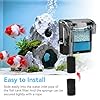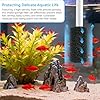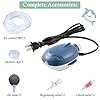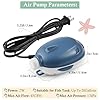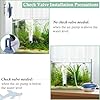The Best Pond Filtration System for 2023
Prefilter Sponge for Fluval AC20/AC30/AC50 Power Filter, Aquarium Filter Intake Sponge, Edge Prefilter Sponge Intake Strainer Cover for Freshwater & Saltwater Aquariums Small Fish Shrimp Fry Fish
$9.99 (as of December 22, 2025 00:35 GMT +00:00 - More infoProduct prices and availability are accurate as of the date/time indicated and are subject to change. Any price and availability information displayed on [relevant Amazon Site(s), as applicable] at the time of purchase will apply to the purchase of this product.)In peaceful garden spots, among the colorful beauty of nature, ponds become a calm place and a safe home for water creatures. A nicely kept pond doesn’t just make your area look better but also makes a good home for the plants and animals that live there. As we step into 2023, the emphasis on creating sustainable and vibrant ecosystems within our gardens has never been more significant. Central to this is the installation of an efficient pond filtration system, a silent guardian that ensures the pristine condition of your pond.
Choosing the right pond filtration system is not just about clear waters; it’s about fostering a thriving aquatic habitat where every element coexists in harmony. Setting realistic expectations, understanding the nuances of various filtration systems, and aligning them with your pond’s unique characteristics are vital steps in achieving this balance.
In this helpful guide, we’ll explore pond filtration systems. We’ll share expert advice from our years of experience. Whether you’re new to ponds or want to improve your current one, this guide will help you make smart choices.
We’ll talk about biological and mechanical filters, and natural options, and even show you how to make your own filter. Let’s work together to create a beautiful pond that’s also a sign of a healthy environment.
Our Top 3 Picks
1

POND CLEANING MACHINE, FOAM FREE FILTER
2

QUICK REMEDY TETRA ICK 8 COUNT GUARD
3

SUBMERSIBLE POND FOR WATER FILTER
Product Reviews
In the ever-evolving market of pond filtration systems, making an informed choice can be a daunting task. To assist you in this endeavor, we have curated a list of top products that have proven to be reliable and efficient. In this section, we delve deep into the features, pros, and cons of each product, providing you with a comprehensive guide to making the right purchase.

1
1- 95110 | SUBMERSIBLE POND FOR WATER FILTER BY AQUASCAPE
9.8
Discover the ultimate solution to maintaining a clean and healthy pond with the Aquascape 95110 Submersible Pond Water Filter. Designed to offer both mechanical and biological filtration, this versatile tool is a must-have for every pond owner. Its user-friendly features and robust construction make it a reliable choice for ensuring the pristine condition of your pond water. Dive into a hassle-free pond maintenance experience with Aquascape.
Key Features
- Dual Filtration System: Offers both mechanical and biological filtration, ensuring clear and healthy water.
- Easy Cleaning: Features easy-to-remove covers, facilitating a straightforward cleaning process.
- Low Maintenance: Equipped with pre-filter pumps that significantly reduce the need for frequent maintenance.
- Variable Warranty: Offers warranty terms that vary based on your geographical location.
- Sleek Design: Comes in a universally acceptable black color, blending seamlessly with your pond surroundings.
What Other Reviewers Say
Most users have praised the Aquascape 95110 Submersible Pond Water Filter for its dual filtration system, highlighting its efficiency in maintaining clear and healthy water in ponds. The easy cleaning feature and sleek design have also been well-received, adding to the user-friendly experience.

2
2- GRECH POND – BIO FILTER PRESSURE – SUN CPF
9.8
Step up your pond maintenance game with the GRECH Pond Bio Filter Pressure CPF-2500, a product designed to safeguard the well-being of your aquatic life. This advanced filtration system, characterized by its ease of use and efficiency, ensures a clean and healthy environment for your water animals at all stages of life. Its dual filtration technology and gravity filters make it a standout choice for pond enthusiasts. Embrace a cleaner, healthier pond with GRECH.
Key Features
- Dual Filtration Technology: Incorporates both biological and mechanical filtration methods to effectively remove dissolved and solid waste.
- Easy Cleaning System: Designed to facilitate easy cleaning without the need to open the chamber repeatedly.
- Ammonia and Nitrate Cleaning: Supports the growth of aerobic bacteria to eliminate harmful substances like ammonia and nitrate, fostering a healthier ecosystem.
- Gravity Filters: Equipped with gravity filters to maintain a steady water flow from the filter.
- Inlet and Outlet Adapters: Features adapters to facilitate smooth water flow, enhancing the filter’s efficiency.
What Other Reviewers Say
Mixed feelings about the filter. Good flow. I have two of these filters on a 300-gallon winter garage holding tank for some of my pond goldfish. The flow is nice and consistent, but I’ve had problems with leaks and the hoses. Cleaning it is messy and inconvenient due to the hose connections

3
3- QUICK REMEDY TETRA ICK 8 COUNT GUARD, FOR AQUARIUMS ICK
9.8
Introducing the Quick Remedy Tetra Ick 8 Count Guard, a revolutionary product designed to maintain the pristine condition of your aquariums. This fast-acting solution, with a proven track record of over 9 years in the market, offers an efficient way to clear unsightly spots on your aquarium glass. Available in vibrant gold and yellow hues, it stands as a reliable guard against aquarium ick, promising a healthy and vibrant aquatic environment.
Key Features
- Effective Filtration: Quickly clears spots on the aquarium glass, enhancing visibility and aesthetics.
- Fast Dissolving Tablets: Designed to dissolve rapidly in the tank, initiating quick action against impurities.
- Temperature Independent: Operates effectively at any temperature, offering flexibility in usage.
- Generous Quantity: Each pack contains enough tablets to treat up to 80 gallons of aquarium water.
- Allergen Information: The product is gelatin-free, making it a safe choice for various aquatic environments.
What Other Reviewers Say
It is a great product except for the fact that as soon as we hooked it up there was a leak right along the lower Seam. We put some epoxy on it and it works fine now. Just be aware of that.

4
4- POND CLEANING MACHINE, FOAM FREE FILTER, BY BLAGDON
9.8
Experience the next level of pond maintenance with the Pond Cleaning Machine, Foam Free Filter by Blagdon. This innovative unit, designed to facilitate easy cleaning and efficient filtration, stands as a reliable companion for keeping your pond pristine and healthy. Its dual filtration technology and user-friendly features make it a must-have for every pond owner. Step into a hassle-free pond cleaning experience with Blagdon.
Key Features
What Other Reviewers Say
The first pix had a separate pump for the waterfall. The second is using the UV filter pump only without the fountain. It doesn’t have the pressure of the original setup. However, there is less water turbulence so floating water plants, like Salvinia and Azolla, will grow better.
Choosing the Right Filtration System
Selecting the perfect filtration system is a pivotal step in fostering a thriving pond ecosystem. It involves a careful analysis of various factors that influence the health and clarity of your pond. In this section, we provide you with expert advice and insights to assist you in making the right choice, ensuring a vibrant and balanced aquatic habitat.
Factors to Consider
Picking the right filter system isn’t the same for everyone. It’s not a “one-size-fits-all” thing. You need to think about lots of different things that affect how well the filter will work. Here, we’ll go over the important stuff to think about:
- Pond Size and Depth: The volume and depth of your pond dictate the capacity and type of filtration system required. Ensure to choose a system that can handle the water volume efficiently.
- Fish Stock Levels: The number and type of fish in your pond influence the load on the filtration system. A higher fish stock necessitates a more robust filtration system to maintain water quality.
- Amount of Debris: Consider the amount of debris entering your pond, such as leaves and dirt. A pond with higher debris levels may require additional mechanical filtration to maintain clarity.
Expert Advice on Selection
Starting the journey to find the right filter system can feel overwhelming. But don’t worry, we’re here to give you some smart advice to help you along the way.
- Consult with Professionals: Seek advice from professionals who have experience in pond management. Their insights can be invaluable in making the right choice.
- Case Studies/Examples: Learn from real-life case studies and examples to understand the practical aspects of different filtration systems.
- Tips from The Lily Farm: Drawing from over a decade of experience, The Lily Farm offers expert advice on selecting and setting up the perfect filtration system for your pond.
Understanding Pond Filtration
In the quest to create a thriving pond ecosystem, understanding the core principles of pond filtration serves as your compass. It is the silent engine that drives the health and clarity of your pond, ensuring a vibrant and thriving habitat. Let’s dissect the various components of pond filtration to equip you with the knowledge needed to make an informed choice.
Biological Filtration
Nature has its ingenious ways of maintaining balance, and biological filtration is a testament to this. At the heart of this system lies the nitrogen cycle, a natural process that transforms harmful substances like ammonia, produced from fish waste and decaying organic matter, into less harmful substances. This transformation is facilitated by beneficial bacteria, which colonize the filter media, breaking down toxins and purifying the water.
The Nitrogen Cycle
Understanding the nitrogen cycle is akin to unlocking the secret to a healthy pond. In this cycle:
- Fish produce waste and other organic matter decays, releasing ammonia into the water, a substance toxic to aquatic life.
- Helpful bacteria, called Nitrosomonas, change ammonia into nitrites, which are still harmful.
- Another set of helpful bacteria, Nitrobacter, then turns nitrites into nitrates, which are not as bad and can be taken in by plants and algae as food.
This continuous cycle ensures the stability and health of your pond, making biological filtration a cornerstone in pond management.
Role of Beneficial Bacteria
Beneficial bacteria are the unsung heroes in the pond ecosystem. They colonize the surfaces of rocks, plants, and especially the biological filter media. These bacteria are really good at turning complicated organic stuff into simple, safe stuff. They’re super important for keeping the water clean. When you use the right filters to help these bacteria grow, your pond stays healthy and the water stays clear.
Now Let’s explore mechanical filtration, another vital component in maintaining a pristine pond environment.
Mechanical Filtration
Mechanical filtration is like the front guard of your pond’s filter system. It keeps working non-stop to get rid of things like leaves, dirt, and algae from the water. This helps keep the water clear and stops yucky stuff from building up, which can make the water bad and have bad germs. Now, let’s look closely at mechanical filtration.
Types of Mechanical Filters
Picking the right kind of filter really matters for mechanical filtration. Here, we explore the different types available:
- Skimmers: These go on top of the water and are great at getting rid of stuff that’s floating before it goes down and rots. They stop yucky stuff from piling up at the bottom of the pond.
- Sediment Filters: These filters catch tiny bits that the skimmers might miss, so your water gets really clean.
- Pre-filters: Often installed before the pump, these filters prevent larger debris from entering and potentially damaging the pump and other filtration systems.
Understanding the functionality and benefits of each type will guide you in selecting the perfect mechanical filter for your pond.
Maintenance Tips
Maintaining your mechanical filter is as crucial as selecting the right type. Regular cleaning and upkeep ensure its efficiency and longevity. Here are some tips to keep your mechanical filter in optimal condition:
- Regular Cleaning: Depending on the load of debris, clean the filter media regularly to prevent clogging and maintain efficient water flow.
- Seasonal Checks: Perform seasonal checks to ensure all components are functioning correctly, especially before the onset of winter and spring.
- Professional Inspection: Consider an annual professional inspection to assess the overall health of your filtration system and make necessary adjustments or replacements.
In the upcoming section, we will venture into the world of sterilizers and UV clarifiers, exploring their role in maintaining a healthy and vibrant pond ecosystem. Stay tuned for more insights and expert advice.
Sterilizers and UV Clarifiers
In the grand scheme of pond filtration, sterilizers and UV clarifiers act as vigilant sentinels, safeguarding your pond from microscopic invaders that can cloud your water and harm your aquatic life. These devices use ultraviolet light to neutralize harmful microorganisms and algae, promoting clear and healthy water. Let’s explore the functionalities and benefits of incorporating these systems into your pond.
Functionality and Benefits
Sterilizers and UV clarifiers operate on a simple yet effective principle: they expose water to ultraviolet light, which alters the DNA of microorganisms like algae, preventing them from reproducing. Here are the benefits of using these systems:
- Algae Control: By neutralizing algae spores, they prevent the dreaded green water phenomenon, maintaining the clarity and aesthetic appeal of your pond.
- Disease Prevention: These systems are effective in controlling pathogens and harmful bacteria, thus reducing the risk of diseases in fish and other aquatic life.
- Improved Water Quality: By controlling algae and harmful microorganisms, they contribute to better water quality, fostering a healthier environment for your pond’s inhabitants.
Choosing the Right UV Clarifier
Picking the right UV clarifier for your pond is really important when you’re setting up a good filter system. Here are some things to think about:
- Pond Size: Choose a UV clarifier that matches the volume of your pond to ensure effective treatment of the water.
- UV Light Strength: The strength of the UV light should be sufficient to neutralize the microorganisms commonly found in your pond.
- Maintenance: Like other components of your filtration system, UV clarifiers require regular maintenance to function optimally. Consider ease of maintenance when choosing a unit.
So, we’ve finished talking about all the parts of pond filters. Now that you know this stuff, you’re all set to make a pond that looks amazing and is super healthy.
Next up, we’ll check out some cool natural ways to clean ponds. These are good for the environment and make sure your pond stays in great shape. Stay tuned!
Natural Filtration Alternatives
In a world that is increasingly leaning towards sustainable and eco-friendly solutions, natural filtration stands as a beacon of harmony between man-made ponds and Mother Nature. This approach leverages the innate filtering capabilities of plants and natural elements to maintain a clean and balanced pond ecosystem. Let’s explore the wonders of natural filtration and how you can integrate them into your pond.
Role of Aquatic Plants
Aquatic plants are like nature’s special cleaners for your pond. They’re super important for keeping the water healthy and clear. Plus, they make your pond look pretty with their green and colorful leaves.
Benefits of Aquatic Plants in Pond Filtration
- Nutrient Absorption: They soak up nutrients like nitrates and phosphates, which come from fish waste and rotting stuff. This keeps bad algae from growing.
- Cleaning the Water: The plant roots catch tiny bits and dirt, stopping the water from getting cloudy and also preventing erosion.
- Home for Aquatic Friends: Besides cleaning, these plants make a safe place for fish and other water creatures to live and have babies. This makes your pond a lively and diverse place.
Here are some tips for making a natural plant cleaning system
- Choose the Right Plants: Pick plants that are local to your area and can handle your pond’s weather and water conditions.
- Put Plants Where They Work: Plant them in spots where they can clean the water well, like near where the water comes in or in shallow parts.
- Maintenance: Regular maintenance, including pruning and removal of dead plants, ensures the effectiveness of your natural filtration system.
Creating a Naturally Balanced Pond
Creating a naturally balanced pond is an art that combines science and nature’s wisdom. This means creating a friendly team with all the things in your pond: the fish, plants, and tiny creatures in the water, so they all help each other out.
Tips and Guidelines
- Biodiversity: Make your pond diverse by adding different plants and aquatic animals. This helps keep the pond healthy and strong.
- Manage Organic Stuff: Keep an eye on how many fish you have and how much you feed them. Don’t give them too much so that your filter can handle it.
- Natural Air: Use things like waterfalls and fountains to add oxygen to the water and keep it moving.
Next up, we’ll show you how to make your own pond filter. It’s a hands-on way to take care of your pond. Get ready for an exciting journey into DIY pond filtration!
DIY Pond Filtration System
If you like being creative and doing things yourself, making your own pond filter can be a satisfying project. It gives you a feeling of success, and you can make it just right for your pond. In this part, we’ll take you through each step to help you build a DIY pond filter that works well and is dependable.
Building Your Pond Filter System
Embarking on a DIY project to build your pond filter system requires a blend of creativity and technical know-how. Here, we provide you with a comprehensive guide to setting up your filtration system from scratch.
Materials Required
Before you begin, gather the necessary materials, which may include:
- A suitable container with a sealable lid
- A quality water pump
- Filter media such as red lava rocks or bio-balls
- Plumbing supplies like hoses and connectors
Step-by-Step Guide (with Pictures and Video)
- Choosing the Right Container: Select a container that can hold the necessary volume of filter media and water flow for your pond size.
- Setting Up the Pump: Install the pump near the pond, ensuring it has the capacity to handle the water volume of your pond.
- Installing the Filter Media: Add a layer of filter media, such as red lava rocks, in the container, followed by additional layers of finer filter materials.
- Connecting the System: Connect the pump to the filter using appropriate plumbing supplies, ensuring a smooth flow of water through the system.
- Testing the System: Once set up, test the system to ensure it operates efficiently, making adjustments as necessary.
Maintenance Tips
Like any other filter system, a do-it-yourself (DIY) filter needs regular care to work well for a long time. Here are some tips to help you keep your system running smoothly:
- Regular Cleaning: Clean the filter media periodically to prevent clogging and maintain optimal water flow.
- Seasonal Adjustments: Make necessary adjustments based on seasonal changes, ensuring the system operates efficiently throughout the year.
- Expert Advice: Seek expert advice or consult online communities for tips and guidance on maintaining and improving your DIY filtration system.
With this, we conclude our guide to building a DIY pond filtration system. In the next section, we will delve into the critical factors to consider when choosing the right filtration system for your pond. Stay tuned for more expert insights and guidance!
Frequently Asked Questions
What is the best type of filtration system for a koi pond?
Answer: The best filtration system for a koi pond combines mechanical and biological filtration elements. Mechanical filtration helps in removing solid debris, while biological filtration manages the conversion of harmful substances into less toxic forms. Incorporating a UV clarifier can also be beneficial in controlling algae growth and maintaining water clarity.
How often should I clean my pond filter?
Answer: The frequency of cleaning your pond filter depends on various factors including the load of debris, fish stock levels, and the type of filter in use. Generally, mechanical filters require more frequent cleaning compared to biological filters. It’s advisable to monitor the water quality and clarity to determine the appropriate cleaning schedule.
Can I use plants as a natural filtration system?
Answer: Absolutely! Plants can serve as an effective natural filtration system. Aquatic plants absorb nutrients like nitrates and phosphates, which are by-products of fish waste and decaying organic matter. They also provide a habitat for beneficial microorganisms, contributing to a balanced and healthy pond ecosystem.
Do I need a UV clarifier for my pond?
Answer: While not mandatory, a UV clarifier can be a valuable addition to your pond filtration system. It helps in controlling algae growth, preventing the green water phenomenon, and maintaining water clarity. It can also assist in controlling pathogens and harmful bacteria, promoting a healthier environment for your aquatic life.
Conclusion
As we reach the conclusion of this extensive guide, we hope to have illuminated the path to achieving a vibrant and thriving pond ecosystem through the effective use of filtration systems. The journey to maintaining a healthy pond is a blend of science and nature’s wisdom, where each component, from mechanical filters to natural plant filtrations, plays a pivotal role.




